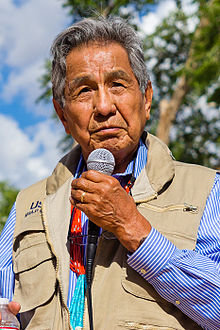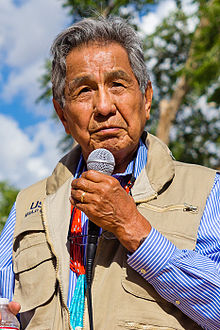Initially tortured because his Japanese captors thought he was Japanese-American (and therefore a traitor), Sergeant Kieyoomia suffered months of beatings before the Japanese accepted his claim to Navajo ancestry. He survived the Bataan Death March in the Philippines that killed thousands of starved U.S. soldiers. When the "Navajo Code" had the Japanese baffled, Sergeant Kieyoomia was questioned and then tortured, although he could only understand bits and pieces of what trained Navajo Code Talkers were saying, the code was so sophisticated that he eventually told the Japanese that it sounded like nonsense to him. Sergeant Kieyoomia was not trained as a code talker and did not know about the code. Stripped naked and made to stand for hours in deep snow until he talked, Sergeant Kieyoomia's feet froze to the ground. Finally allowed to return to his cell, a guard shoved him, causing the soles of his feet to tear. After surviving the prison camps, the "hell ships" and the torture, Sergeant Kieyoomia was a prisoner in Nagasaki when that city was the target of the second atomic bomb dropped by U.S. B-29 Superfortress. Sergeant Kieyoomia survived the atomic bombing attack saying he was protected by the concrete walls of his cell. After 3-1/2 years as a POW, he was abandoned for three days after the atomic bombing, but he said a Japanese officer finally freed him. He returned to the United States after being released and rescued by U.S. forces.
Initially tortured because his Japanese captors thought he was Japanese-American (and therefore a traitor), Sergeant Kieyoomia suffered months of beatings before the Japanese accepted his claim to Navajo ancestry. He survived the Bataan Death March in the Philippines that killed thousands of starved U.S. soldiers. When the "Navajo Code" had the Japanese baffled, Sergeant Kieyoomia was questioned and then tortured, although he could only understand bits and pieces of what trained Navajo Code Talkers were saying, the code was so sophisticated that he eventually told the Japanese that it sounded like nonsense to him. Sergeant Kieyoomia was not trained as a code talker and did not know about the code. Stripped naked and made to stand for hours in deep snow until he talked, Sergeant Kieyoomia's feet froze to the ground. Finally allowed to return to his cell, a guard shoved him, causing the soles of his feet to tear. After surviving the prison camps, the "hell ships" and the torture, Sergeant Kieyoomia was a prisoner in Nagasaki when that city was the target of the second atomic bomb dropped by U.S. B-29 Superfortress. Sergeant Kieyoomia survived the atomic bombing attack saying he was protected by the concrete walls of his cell. After 3-1/2 years as a POW, he was abandoned for three days after the atomic bombing, but he said a Japanese officer finally freed him. He returned to the United States after being released and rescued by U.S. forces.



